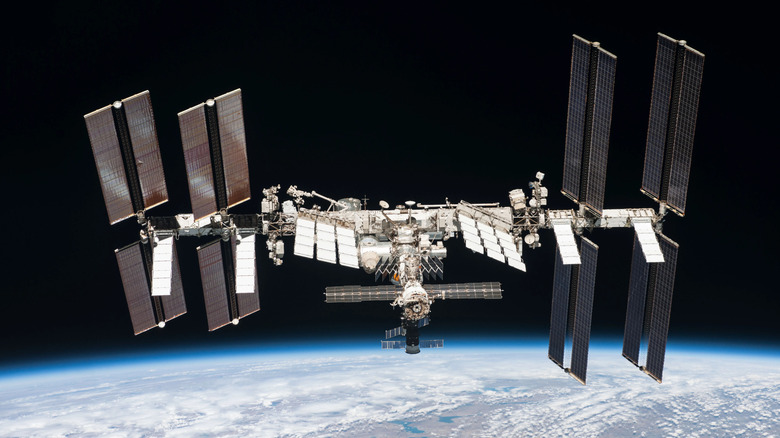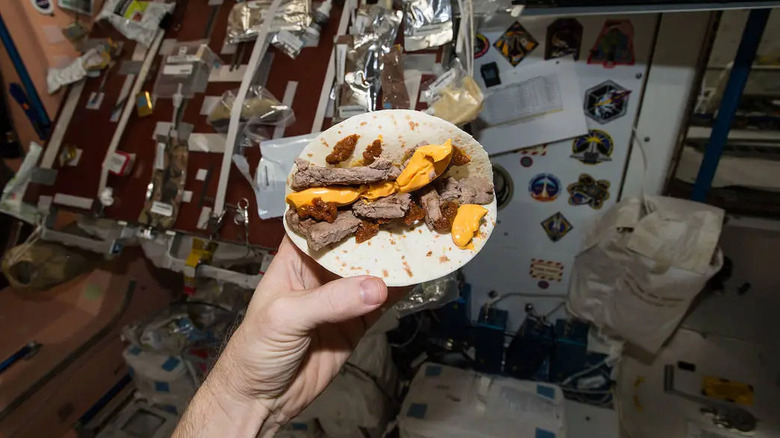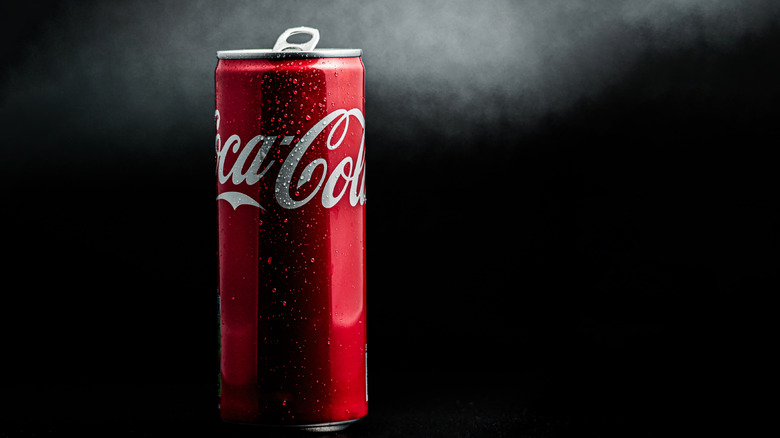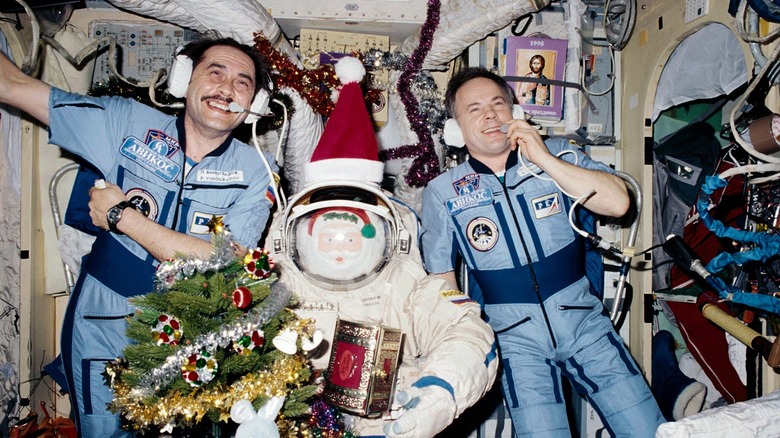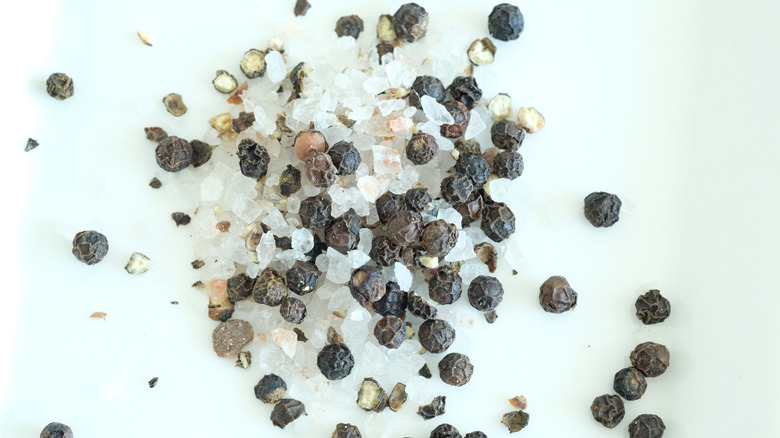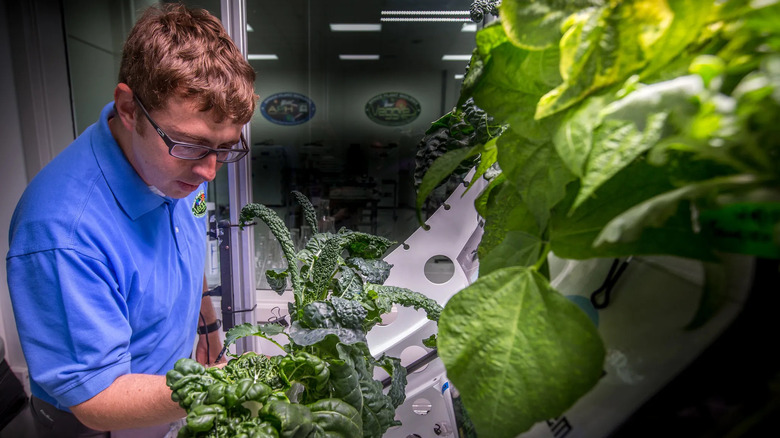Foods Astronauts Are Banned From Eating On The ISS
When most of us imagine astronauts at the International Space Station (ISS), we often think about the impressive technology that allows them to conduct their research missions or the truly awesome views of planet Earth they're privileged to see. Just as crucial to the scientific research taking place in Earth's orbit are the details of everyday life that make these missions possible in the first place.
Food is no exception. Astronauts need to eat well, not just to get proper nutrition in their systems, but to ensure they stay healthy — a factor that has a significant effect on their ability to do their job. But setting the dinner table in zero-gravity presents its own challenges, and some foods are simply a non-starter aboard a spacecraft with sensitive systems helping carry out some of the most important research off the planet (not to mention the ones keeping the astronauts alive).
Because of this highly specialized environment, several foods are banned aboard the ISS, with some of the restrictions being more intuitive to understand than others. Here's a list of items astronauts won't be eating during their stay aboard the ISS — and a few of the times in the history of space exploration when people smuggled food and drink onboard that wasn't exactly officially sanctioned.
Bread
Astronauts aboard the International Space Station (ISS) are not allowed to eat bread. The culprit? Crumbs. In the weightlessness of microgravity, crumbs from bread (and other crumbly foods) become dangerous floating objects that NASA classifies as Foreign Object Debris (FOD). These are any materials or particles that might cause damage to equipment, making it unsafe, less efficient, or entirely inoperable.
The danger of taking bread into space became clear when, on March 23, 1965, astronaut John Young smuggled a corn-beef sandwich into the pocket of his space suit during NASA's Gemini III mission. Taking the sandwich out around two hours into the five-hour flight, Young offered the sandwich to the mission's commander, Virgil Grissom. The interaction lasted less than one minute, with Young quickly putting the sandwich away to reduce the number of crumbs that were rapidly breaking off, posing the risk of floating into the astronauts' eyes or an instrument panel.
The solution to this problem came about when NASA Payload Specialist Rodolfo Neri Vela — a crew member aboard the space shuttle Atlantis during its STS-61B mission in 1985 — requested tortillas to be included in his food supply. In orbit, the crew noticed that the tortillas didn't create crumbs and served as a great substitute for making sandwiches. Since that mission, tortillas have become a favorite for astronauts in space, being used to make hamburgers, breakfast burritos, and peanut butter and jelly sandwiches.
Soda and other carbonated drinks
On the International Space Station, carbonated beverages don't behave like they would on Earth. Because of the lack of gravity on the station, the gas bubbles inside a liquid don't float to the top of the container and escape, simply because in that environment, there is no top.
This means that astronauts would consume far more gas than usual when drinking a carbonated beverage, resulting in their needing to burp often. This is an unpleasant experience for astronauts because the same microgravity that keeps the liquid and gases together in a container in space would keep them together in the astronaut's stomach. Any burping would be a wet mixture of liquid and gas similar to acid reflux, creating its own problems as astronauts struggle to keep the liquid from causing any harm to their surrounding equipment.
Interestingly, in 1985, NASA tested carrying specially designed Coca-Cola and Pepsi containers into space on the agency's STS-51-F mission. Both companies developed soda delivery systems that would keep the beverage fizzy without having it uncontrollably spray out into its surroundings upon consumption. However, astronauts responded to these cans with mixed feelings, leading NASA to decline to add the products to its array of space food supplies.
Alcohol
Astronauts onboard the International Space Station are no strangers to celebrating the holidays or special events while orbiting the Earth, it's just that they do so with no alcohol. Apart from the obvious — you don't want drunken errors when you're dealing with hundreds of billions of dollars worth of equipment in the vacuum of space — there's actually a technical reason for its banning, too.
Alcohol poses a risk to the space station's Environmental Control and Life Support System (ECLSS). This system's primary responsibility is to maintain the station's clean air and water supply, which it accomplishes by recycling urine and even condensation. If an astronaut is consuming and breathing out chemical contaminants like ethanol (a key ingredient in alcohol) the compound could interfere with the life support system by messing with its strict purity standards.
That doesn't mean that there is no history of astronauts smuggling alcohol onboard during their missions, however. Perhaps the best-known example of this occurred on the Russian Mir Space Station in the 1980s and 1990s, when astronauts defied official Russian alcohol policy by bringing along cognac on their missions to help crew members relax and socialize.
Salt and pepper
Traditional seasoning is also a no-go in space, at least not in the way you might think. Given that both salt and pepper are composed of small granular particles, having these float about on the International Space Station could mean disaster for the station and its crew. Similar to how breadcrumbs would be problematic for equipment, tiny salt grains could get into all kinds of problematic spaces in orbit, including astronauts' eyes.
Thankfully, neither seasoning is banned entirely. Instead, astronauts use polyethylene dropper bottles that hold solutions of liquid salt and pepper. The salt is dissolved in water, while the pepper is suspended in oil, the two being applied like condiments to whatever food a crew member desires. Other seasoning and condiment options for ISS members include soy sauce (which also comes in a dropper bottle form) and mayonnaise, which has had the oxygen in its vegetable oil removed to provide a longer shelf life.
The future of food in space
Thanks to advances in technology, the culinary diversity aboard the International Space Station has grown significantly over the years, and it continues to evolve. Astronauts can now even grow edible crops onboard the ISS via the station's Vegetable Production System. This space garden helps scientists study how plants grow in microgravity while providing fresh food to astronaut diets.
As the station's crew diversity has grown over the years, and so has its food range. Today, crew members have nearly 200 different menu items to choose from, and these can be added in accordance with astronauts' personal preferences when they fit the safety and nutrition requirements. In the last few years, astronauts have even been able to enjoy special treats and snacks that remind them of home, thanks to some ingenuity and extra planning. The ISS has no dedicated freezer onboard, but cargo vehicles do feature freezers meant for returning science samples, and these often launch to the station empty. This means they are occasionally used to bring up specialized items like ice cream for immediate consumption.
